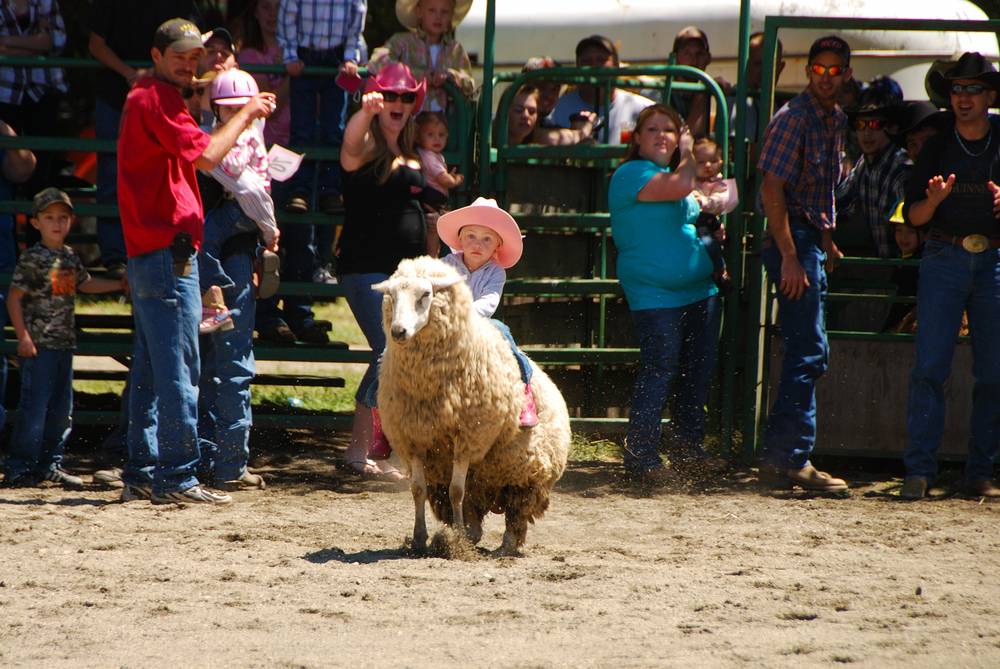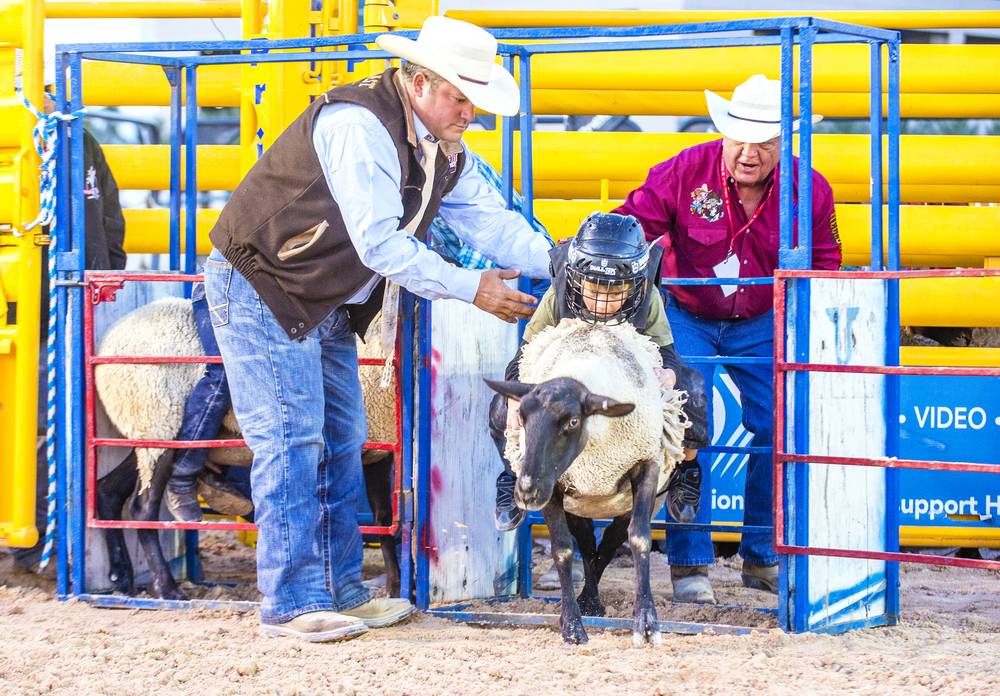
Mutton busting is a well-known rodeo activity that involves children riding sheep for sport and competition. The child holds on to the sheep as it emerges from a chute, aiming to stay on the animal for a predetermined duration without falling off. Mutton bustin is a distinctive event frequently showcased at rodeos, state and county fairs, as well as other western-themed festivals throughout the United States.
The History of Mutton Bustin Event
Mutton busting originated as an entertaining side event at rodeos and fairs in the western United States during the 1980s and 1990s. Although its precise origins remain ambiguous, it gained popularity as a local attraction. Mutton bustin takes place regularly in the states like Colorado, Wyoming, and Texas. The National Western Stock Show, a well-known stock show and rodeo hosted annually in Denver since 1906 is often acknowledged as the first to popularize mutton bustin as a specialized event in the rodeo circuit
From its Western roots, mutton busting is a crowd favorite that has rapidly gained popularity at fairs and rodeos across the nation throughout the 1990s and 2000s. Today, it has become a regular staple at major rodeos and state fairs throughout the United States. The event pays homage to the heritage of sheep ranching in the American West, which greatly contributes to its appeal among rodeo enthusiasts of all ages.
How Mutton Busting Works
Mutton bustin competitions are open to children between the ages of 4 and 7 and weighing less than 55 pounds. These events involve kids riding sheep across a short dirt arena, typically ranging from 15 to 30 feet in length. To ensure the safety of the sheep, they have pads and coats wrapped around their backs and flanks. Child riders are required to wear an approved helmet with a chin strap, and some events also use a rope tied around the waist for added safety.
The objective is for the child to stay on the sheep for at least six exciting seconds without falling off or using their free hand to touch the ground. Competitions usually consist of multiple qualifying rounds, leading to a final championship round. Prior to the ride, young rodeo contestants either pick up or are placed on the sheep while waiting in a chute adjacent to the arena. Once the sheep is released, the rider must maintain a firm grip to stay balanced as the sheep runs. These events are short but exhilarating rodeo performance, providing an exciting experience for young riders.

Strategies for Successful Mutton Busting
There are several effective strategies that young rodeo riders can employ to achieve success and maintain their position on the sheep during the thrilling ride. An important aspect is to firmly grasp the sheep’s fleece or wool coat, ensuring a secure grip. Maintaining a low center of gravity as well as leaning forward over the sheep’s shoulders and neck can provide a more stable foundation. Riders should angle their toes outward and firmly plant them into the animal’s flank for added stability.
It is also beneficial to keep arms and head tucked in tightly, minimizing any loose limbs that may disrupt balance. During the ride itself, skilled mutton busters will absorb the sheep’s movements by flexing their knees and elbows, preventing premature dismounting. For parents, allowing children to practice on soft surfaces like pillows at home can aid in their preparation for the actual event. By gaining confidence through practice rides, first-time sheep riders can overcome any anxiety or fear prior to competing. Since then, the young rider may be interested in mounting a bigger ride like a horse.
Popularity and Controversy
Over the past thirty years, mutton bustin has gained immense popularity and has become a prominent attraction at rodeos and state fairs throughout the nation. It offers rodeo organizers a unique opportunity to engage young children directly in the action and introduce them to the sport from an early age. Many children are captivated by its enjoyable and adventurous atmosphere.
However, mutton bustin has also sparked controversy regarding safety and its appropriateness for children. Supporters argue that with appropriate safety gear, it is relatively safe, helps develop riding skills, and boosts children’s confidence. On the other hand, critics express some concerns about potential fall-related injuries and the ethical treatment of animals, as the sheep do not willingly participate. Opinions on this topic vary widely, leading to enduring debates about the ethics and safety risks associated with promoting mutton bustin’ as a children’s event.

Frequently Asked Questions
1. What are the rules and restrictions for mutton busting events?
Mutton bustin’ events can differ, but generally, they have regulations regarding age (4-7 years old), weight limits (usually 50-60 lbs), safety equipment such as helmets, and the challenge of holding onto a sheep for 6 seconds without touching the ground. Often, there are preliminary rounds leading up to the finals.
2. How much do mutton busting tickets cost?
General admission ticket prices for mutton busting typically range from $15-$50 per adult. Children’s tickets are often discounted.
3. How are the sheep prepared and cared for during mutton busting events?
Sheep have padding and coats for protection on their backs and flanks. Handlers are present to assist them in chutes, while vets conduct pre and post-ride check-ups. Sheep are usually rotated between young riders and adults to ensure a fair experience.
4. Where did the name “mutton bustin” come from?
The term “busting” or riding rough stock animals such as sheep or mutton in rodeos is the origin of the name. This is similar to events like bull riding or bronc riding, but with larger livestock.
5. How fast can the sheep run during mutton bustin’ events?
Sheep have the ability to reach speeds of 15-25 mph when a small rider is on their backs. This serves the purpose of swiftly dislodging riders. The top speeds achieved may vary depending on the size of the sheep and the length of the arena.
6. How much practice do youth riders need to be successful?
Most individuals receive limited formal training beyond parental guidance. While additional practice can be beneficial, the speed of rides makes natural balance and grip significant contributing factors.
7. What are the benefits or lessons of mutton busting for kids?
Supporters assert that it fosters self-assurance, equilibrium, resilience, and acquaints children with rodeo sports. Detractors argue that it encourages immoral treatment of animals for amusement.
Conclusion
Mutton busting has undeniably gained popularity in the modern rodeo circuit as a way for young children to participate in riding competitions. While some consider it a fun tradition that reflects the ranching heritage of the West, others express concerns about the potential risks it poses to both children and animals. Despite the ongoing controversies, mutton bustin continues to attract large crowds of parents and fans who enjoy watching young cowboys and cowgirls take on sheep in the rodeo arena. It remains a unique rodeo event that is steadily gaining popularity across North America, evoking mixed opinions and discussions.
